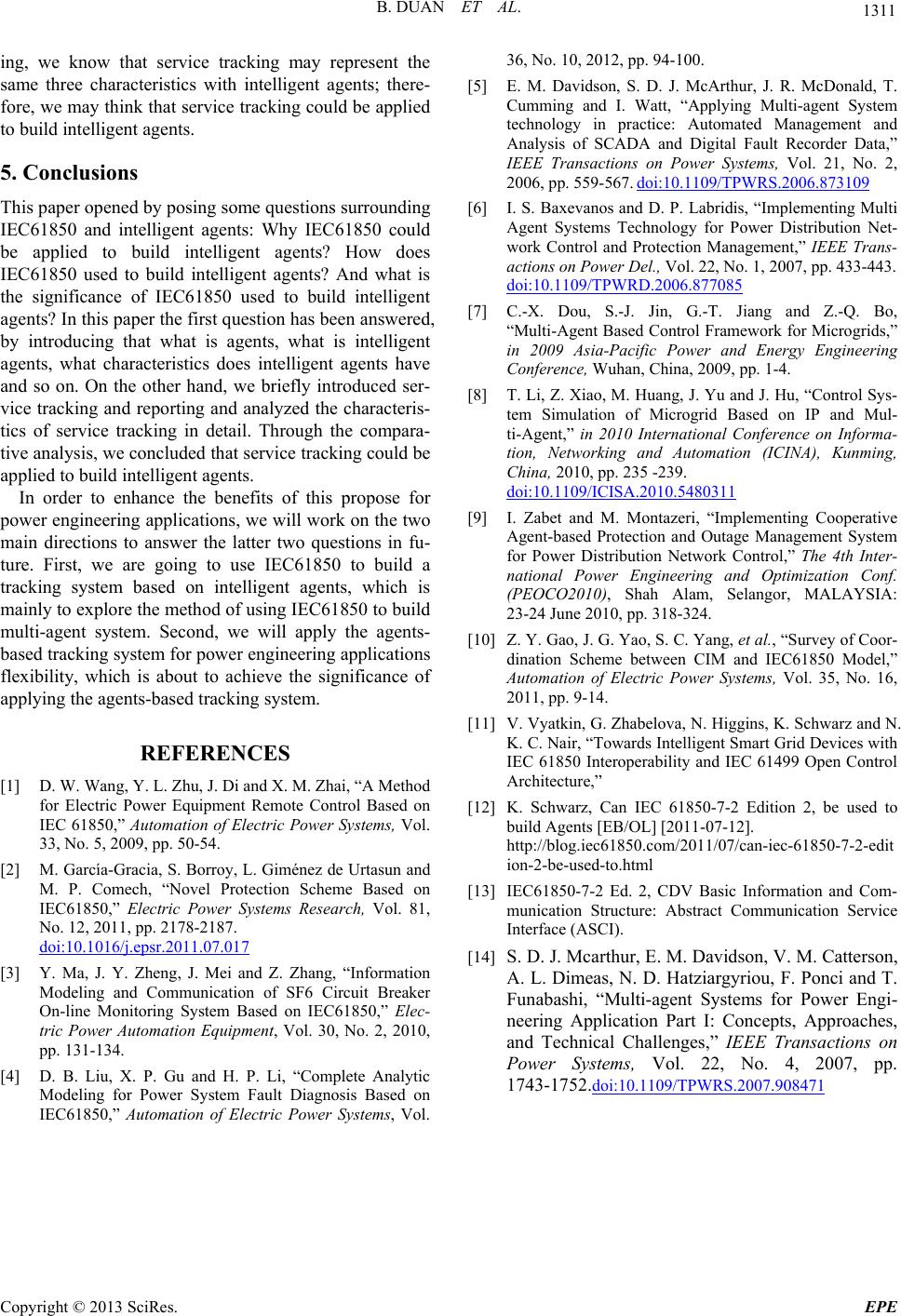
B. DUAN ET AL.
Copyright © 2013 SciRes. EPE
1311
ing, we know that service tracking may represent the
same three characteristics with intelligent agents; there-
fore, we may think that service tracking could be applied
to build intelligent agents.
5. Conclusions
This paper opened by posing some questions surrounding
IEC61850 and intelligent agents: Why IEC61850 could
be applied to build intelligent agents? How does
IEC61850 used to build intelligent agents? And what is
the significance of IEC61850 used to build intelligent
agents? In this paper the first question has been answered,
by introducing that what is agents, what is intelligent
agents, what characteristics does intelligent agents have
and so on. On the other hand, we briefly introduced ser-
vice tracking and reporting and analyzed the characteris-
tics of service tracking in detail. Through the compara-
tive analysis, we concluded that service tracking could be
applied to build intelligent agents.
In order to enhance the benefits of this propose for
power engineering applications, we will work on the two
main directions to answer the latter two questions in fu-
ture. First, we are going to use IEC61850 to build a
tracking system based on intelligent agents, which is
mainly to explore the method of using IEC61850 to build
multi-agent system. Second, we will apply the agents-
based tracking system for power engineering applications
flexibility, which is about to achieve the significance of
applying the agents-based tracking system.
REFERENCES
[1] D. W. Wang, Y. L. Zhu, J. Di and X. M. Zhai, “A Method
for Electric Power Equipment Remote Control Based on
IEC 61850,” Automation of Electric Power Systems, Vol.
33, No. 5, 2009, pp. 50-54.
[2] M. García-Gracia, S. Borroy, L. Giménez de Urtasun and
M. P. Comech, “Novel Protection Scheme Based on
IEC61850,” Electric Power Systems Research, Vol. 81,
No. 12, 2011, pp. 2178-2187.
doi:10.1016/j.epsr.2011.07.017
[3] Y. Ma, J. Y. Zheng, J. Mei and Z. Zhang, “Information
Modeling and Communication of SF6 Circuit Breaker
On-line Monitoring System Based on IEC61850,” Elec-
tric Power Automation Equipment, Vol. 30, No. 2, 2010,
pp. 131-134.
[4] D. B. Liu, X. P. Gu and H. P. Li, “Complete Analytic
Modeling for Power System Fault Diagnosis Based on
IEC61850,” Automation of Electric Power Systems, Vol.
36, No. 10, 2012, pp. 94-100.
[5] E. M. Davidson, S. D. J. McArthur, J. R. McDonald, T.
Cumming and I. Watt, “Applying Multi-agent System
technology in practice: Automated Management and
Analysis of SCADA and Digital Fault Recorder Data,”
IEEE Transactions on Power Systems, Vol. 21, No. 2,
2006, pp. 559-567. doi:10.1109/TPWRS.2006.873109
[6] I. S. Baxevanos and D. P. Labridis, “Implementing Multi
Agent Systems Technology for Power Distribution Net-
work Control and Protection Management,” IEEE Trans-
actions on Power Del., Vol. 22, No. 1, 2007, pp. 433-443.
doi:10.1109/TPWRD.2006.877085
[7] C.-X. Dou, S.-J. Jin, G.-T. Jiang and Z.-Q. Bo,
“Multi-Agent Based Control Framework for Microgrids,”
in 2009 Asia-Pacific Power and Energy Engineering
Conference, Wuhan, China, 2009, pp. 1-4.
[8] T. Li, Z. Xiao, M. Huang, J. Yu and J. Hu, “Control Sy s-
tem Simulation of Microgrid Based on IP and Mul-
ti-Agent,” in 2010 International Conference on Informa-
tion, Networking and Automation (ICINA), Kunming,
China, 2010, pp. 235 -239.
doi:10.1109/ICISA.2010.5480311
[9] I. Zabet and M. Montazeri, “Implementing Cooperative
Agent-based Protection and Outage Management System
for Power Distribution Network Control,” The 4th Inter-
national Power Engineering and Optimization Conf.
(PEOCO2010), Shah Alam, Selangor, MALAYSIA:
23-24 June 2010, pp. 318-324.
[10] Z. Y. Gao, J. G. Yao, S. C. Yang, et al., “Survey of Coor-
dination Scheme between CIM and IEC61850 Model,”
Automation of Electric Power Systems, Vol. 35, No. 16,
2011, pp. 9-14.
[11] V. Vyatkin, G. Zhabelova, N. Higgins, K. Schwarz and N.
K. C. Nair, “Towards Intelligent Smart Grid Devices with
IEC 61850 Interoperability and IEC 61499 Open Control
Architecture,”
[12] K. Schwarz, Can IEC 61850-7-2 Edition 2, be used to
build Agents [EB/OL] [2011-07-12].
http://blog.iec61850.com/2011/07/can-iec-61850-7-2-edit
ion-2-be-used-to.html
[13] IEC61850-7-2 Ed. 2, CDV Basic Information and Com-
munication Structure: Abstract Communication Service
Interface (ASCI).
[14] S. D. J. Mcarthur, E. M. Davidson, V. M. Catterson,
A. L. Dimeas, N. D. Hatziargyriou, F. Ponci and T.
Funabashi, “Multi-agent Systems for Power Engi-
neering Application Part I: Concepts, Approaches,
and Technical Challenges,” IEEE Transactions on
Power Systems, Vol. 22, No. 4, 2007, pp.
1743-1752.doi:10.1109/TPWRS.2007.908471